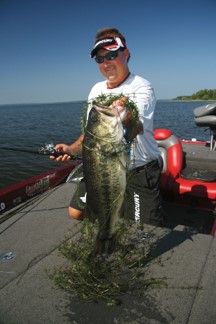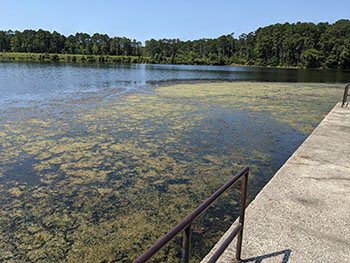Management of Hydrilla in Texas Reservoirs
 Texas Parks and Wildlife Department (TPWD) coordinates closely with reservoir controlling authorities and local stakeholders to make recommendations, provide data, and review all treatment proposals for management of hydrilla to ensure consistency with the State Aquatic Vegetation Plan (TAC Title 31, Rule § 57.932). Reservoir controlling authorities are ultimately responsible for making the decision on whether any treatment of hydrilla will occur and the specific treatment methods to be used.
Texas Parks and Wildlife Department (TPWD) coordinates closely with reservoir controlling authorities and local stakeholders to make recommendations, provide data, and review all treatment proposals for management of hydrilla to ensure consistency with the State Aquatic Vegetation Plan (TAC Title 31, Rule § 57.932). Reservoir controlling authorities are ultimately responsible for making the decision on whether any treatment of hydrilla will occur and the specific treatment methods to be used.
In addition to the reservoir controlling authority, TPWD works with recreational users, local municipalities, shoreline property owners, and other stakeholders as the appropriate management strategies are identified. Any treatment plan will consider potential effects on the fishery with the goal of maintaining sufficient aquatic vegetation coverage to support an improved fishery, while also considering impacts to other stakeholders and reservoir use.
 TPWD recognizes the positive impact hydrilla can have on populations of Largemouth Bass and other species, angling opportunities, and related local economic benefits as reservoirs age, while also recognizing hydrilla can become invasive and negatively impact access to the water, recreational boating (i.e., impeding navigation), and operations by controlling authorities. TPWD carefully considers all these perspectives when making recommendations to the controlling authority.
TPWD recognizes the positive impact hydrilla can have on populations of Largemouth Bass and other species, angling opportunities, and related local economic benefits as reservoirs age, while also recognizing hydrilla can become invasive and negatively impact access to the water, recreational boating (i.e., impeding navigation), and operations by controlling authorities. TPWD carefully considers all these perspectives when making recommendations to the controlling authority.
Reservoirs with hydrilla each present a unique set of circumstances in terms of the potential hydrilla management strategies, and recommendations may range from routine monitoring, to targeted treatments, to large-scale integrated pest management strategies. TPWD conducts routine monitoring of public waterbodies where hydrilla is present to evaluate coverage, inform management recommendations, and communicate with stakeholders. In determining the potential need for large-scale treatment of hydrilla, a variety of factors are considered. Each reservoir is evaluated and managed individually under its own set of circumstances.
Recent publications on Hydrilla- TPWD Inland Fisheries Division Position Paper – “Management of Hydrilla in Texas Reservoirs” (Updated January 3, 2023)
- TPWD Inland Fisheries Technical Review Paper – Hydrilla in Texas Reservoirs (in development)